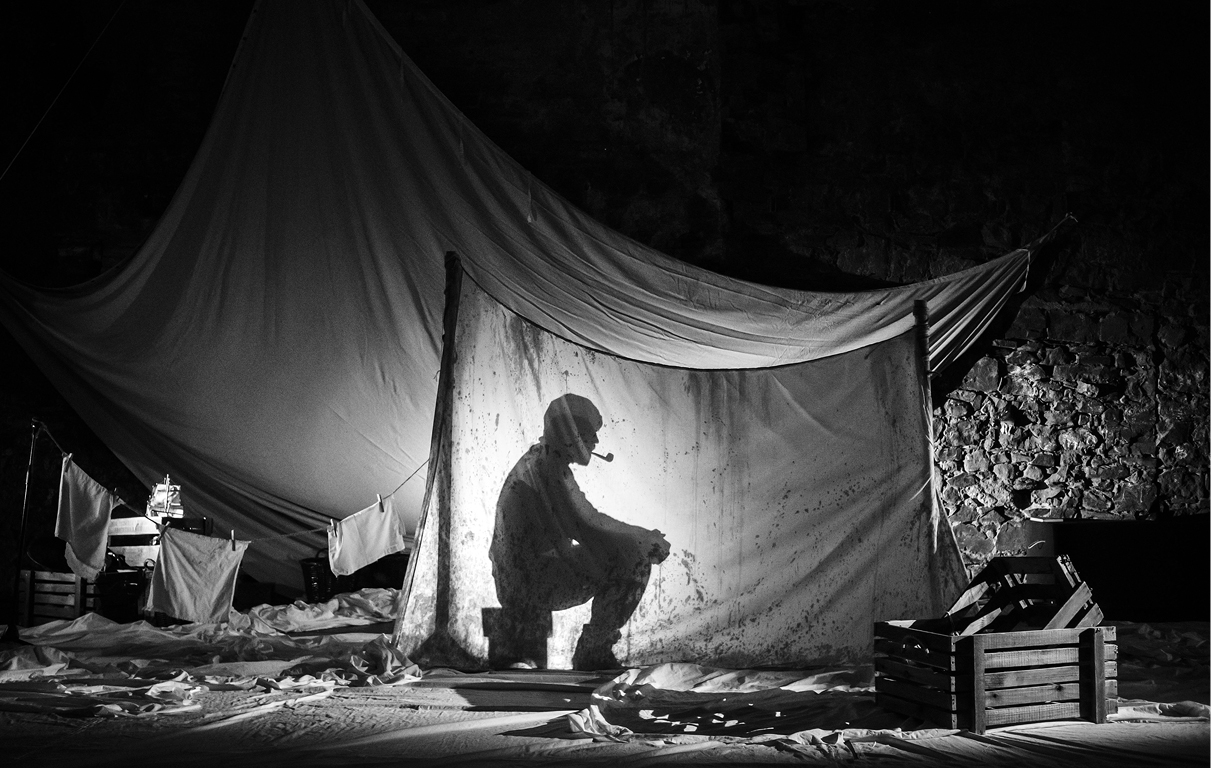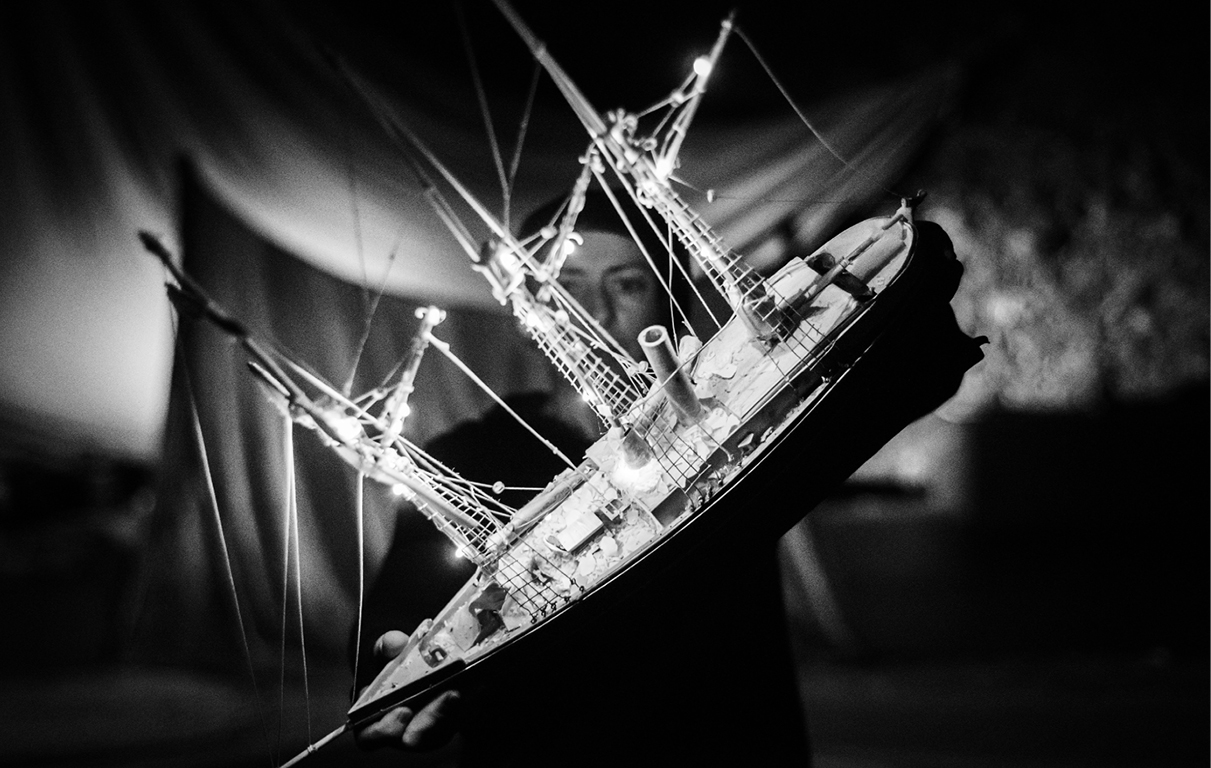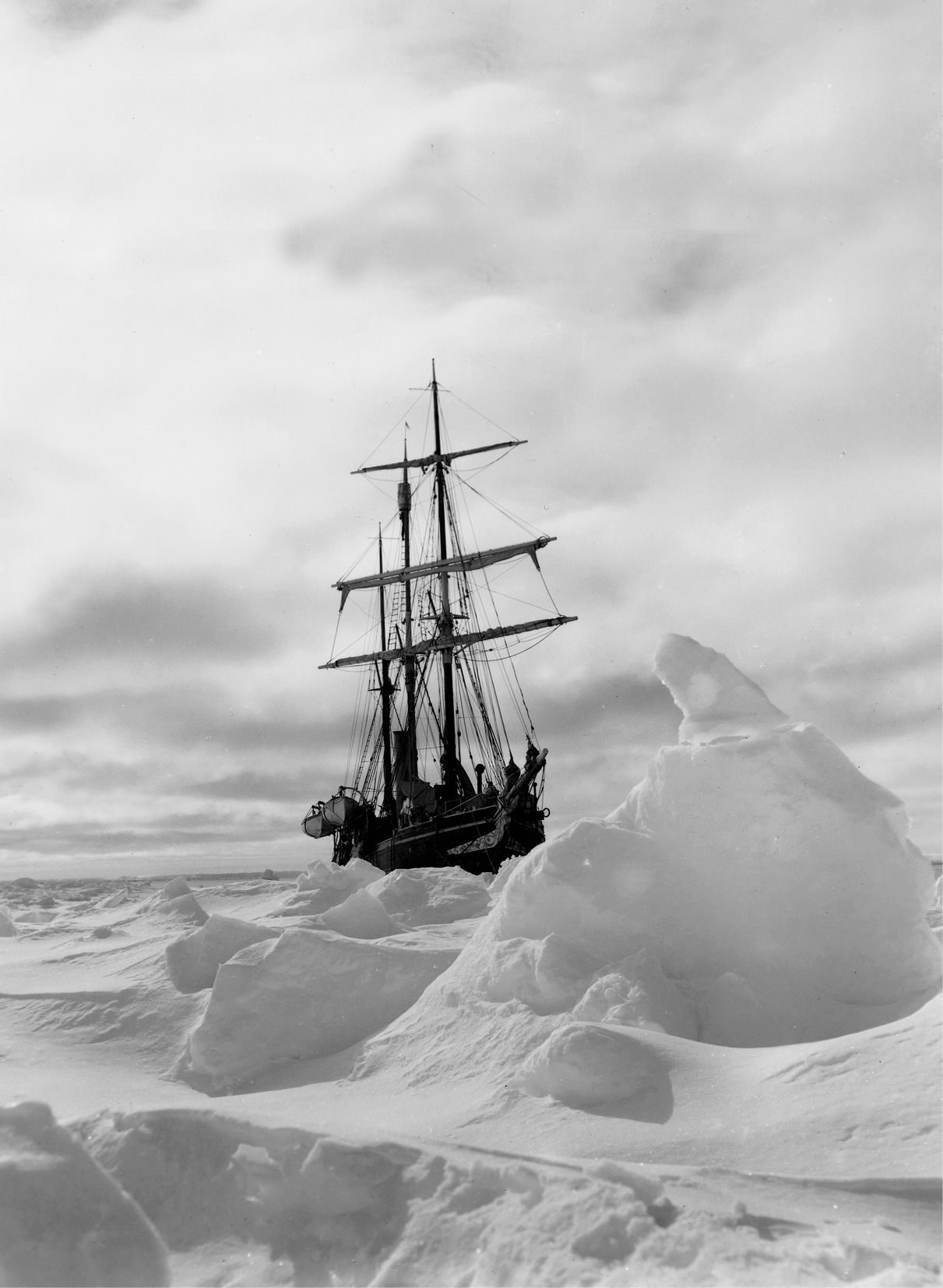Top row: photos by Peter Martin. Bottom: photo by Frank Hurley.
Picture the earth as an astronaut might see it, luminous against the backdrop of space. How does it feel to stare back at it from such distance? Is the experience God-like, distancing; or is it humbling, a reminder of our own vulnerability?
In the darkness of the theatre a tightly-packed audience watches a world in miniature. Slow-moving giants assemble icebergs around a stranded ship. Each coagulation is carefully scored, the tectonic movements of ice floe grinding like bone in socket. The ship’s foundering is inevitable, and compelling. We know its fate – this is the story of Ernest Shackleton and the voyage of the Endurance, after all – and yet we’ve never witnessed it from this angle. The ship’s masts cast jagged shadows across the accumulating ice, committing a violence against its blankness; we are reminded that here, humanity is the freakish interloper.
We catch glimpses of survival, each more outlandish than the last. A man smoking his pipe in a tent becomes unheimlich in this elemental world, where we’ve become attuned to the music of ice and melt, of wave and rock. Lifeboats tossed on waves become as strange as deep-sea fish, their tiny lanterns skating waves in a blackening void. As the crew of the Endurance survive hardship after hardship, their collective will to persevere becomes almost incomprehensible. They are out of their element and there’s no way home.
Except, of course, we know the story. The crew survives. Feats of heroism are accomplished – this we have been shown many times, told in many stories. But how often are we given the chance to take on the mantle of nature’s dispassionate judgment of man and his endeavours – to look at the earth from above? It’s a strange kind of empowerment, made possible through the work of Sligo’s Blue Raincoat Theatre Company.
*
‘The Overview Effect’ is the shift in perspective experienced by astronauts seeing the earth from space for the first time. It’s a term coined in 1987 by astronaut Frank White. While seeing the source of all human life floating away from you in the void creates a sense of existential dread, it can also foster empathy; a new understanding of the fragility of humanity and our ecosystems. Carl Sagan famously describes the experience in his book The Pale Blue Dot:
Look again at that dot. That’s here. That’s home. That’s us. On it everyone you love, everyone you know, everyone you ever heard of, every human being who ever was, lived out their lives. The aggregate of our joy and suffering, thousands of confident religions, ideologies, and economic doctrines, every hunter and forager, every hero and coward, every creator and destroyer of civilization, every king and peasant, every young couple in love, every mother and father, hopeful child, inventor and explorer, every teacher of morals, every corrupt politician, every “superstar,” every “supreme leader,” every saint and sinner in the history of our species lived there – on a mote of dust suspended in a sunbeam.
As far back as 1948, astronomer Fred Hoyle suspected that space travel would bring not just a discovery of other worlds, but a discovery of the self. ‘Once a photograph of the Earth, taken from the outside, is available …’ he said, ‘a new idea as powerful as any in history will be let loose.’ Meanwhile, in Paris, Samuel Beckett was writing Waiting for Godot, a play that probes the tensions between the intolerability of existence, and the impossibility of non-existence. An audience watching the play happen (or perhaps, more aptly, not happen) through the lens of Vladimir and Estragon’s painful endurance may feel the same awe, the same tenderness an astronaut feels looking back at the earth for the first time. We tend to think of sci-fi as work that explores the outer edges of experience but, of course, the best sci-fi probes the inner reaches.
*
In The Factory in Sligo, Blue Raincoat’s rehearsal and performance space, the company’s artistic director Niall Henry sits in a cool space within the thick stone walls of the 200-year-old warehouse, surrounded by some of the company’s more singular props. A rhinoceros head from the eponymous Eugene Ionesco play juts from one wall, facing down a sinister ventriloquist’s dummy. A veiled woman stands with her face to another wall. A rectangle of sunlight spills through the open door after recent drizzle. Henry is considering how best to create the Overview Effect in a theatre space.
Founded in 1991, and with a repertoire that includes European classics and new work, much of Blue Raincoat’s work has dealt with man and the elements; from 2003’s The Strange Voyage of Donald Crowhurst, to 2013’s The First Cosmonaut and, most recently, 2016’s Shackleton. But it would be a mistake to interpret these plays as a straightforward celebration of the spirit of adventure. Henry points out that the drive behind these plays owes more to the absurdist explorations of Beckett and Ionesco: ‘The strong coalition between the underlying themes of [Ionesco’s] The Chairs, or Shackleton, or The First Cosmonaut, is that they’re always dealing with the existential – or how I understand the existential – as the nature of reality and the nature of our sense of the reality that we live in.’
In The First Cosmonaut, the company told the story of Yuri Gagarin as a play within a play, presenting themselves as a Russian theatre troupe making their first trip to Ireland. What had first attracted Henry and long-time Blue Raincoat collaborator and dramaturg Jocelyn Clarke to the story was an article telling of how Yuri Gagarin had landed Sputnik in the very field in which he’d learned to fly, and in a ship with no controls. But as they explored the story further, the allure of this dramatic coincidence diminished as a bigger ambition emerged, focusing on the possibility of the immersive effect of a theatrical presentation creating its own kind of Overview Effect. As Henry recounts it, they asked themselves: ‘How could we do this play that was ostensibly about Yuri Gagarin, but wasn’t really, how could we create that feeling of looking at the earth from space, in a theatre? That was the objective.’
Their solution was to take a leaf from Ionesco, to break the fourth wall and directly implicate the audience at the play’s end. Ciarán McAuley, the actor playing the troupe leader, showed the audience the famous ‘Pale Blue Dot’ image taken by Voyager One, thus shifting the focus of the play’s end from the tale of one man’s heroism to a whole-earth experience. ‘Ciarán showed this to the audience and said to them, “this is us.” They obviously didn’t think they were in a spaceship looking back at earth, but somehow the device of theatre was able to make them think about themselves in broader contexts. So the Yuri Gagarin thing was essentially a vehicle to go somewhere else … Shackleton’s the same.’
In Shackleton, Blue Raincoat as a company and ensemble have pushed this convention to challenging and rewarding new extremes. Dispensing with text altogether – apart from Shackleton’s famous ad promising ‘low wages, bitter cold, long hours of complete darkness’ – the play focuses on our perception of events, pushing us into a dissociative space where we may feel like David Bowie’s Major Tom, lamenting that ‘planet earth is blue / and there’s nothing I can do’, before the play’s action slowly reels us back to a place of renewed empathy. The crew are never individuated for us, never given names or lines to speak, and the convention of a Boy’s Own-style adventure is scrupulously avoided. Henry smiles as he talks about the reasoning behind this: ‘We’ve no interest in telling stories about men who climbed mountains – Shackleton is a story of failure and derring-do survival. The failure thing is mildly interesting, but the derring-do thing is of no interest to us.’
What really appealed to the company was the atmosphere of the imagery captured by photographer Frank Hurley, who accompanied the crew on their voyage. While Scott’s team on the Terra Nova expedition also had a photographer, the shots taken were posed and Victorian – Hurley’s are strange, ominous, both expansive and claustrophobic, artistic statements in their own right. In one shot, the Endurance perches atop a field of icebergs, a scratchy black shape in a whipped cream landscape. In another, taken at night, it’s etched bone-white against the black of the sky. Finally, after the ice destroys the ship, all that’s left is a field of debris polluting the pristine white. They images look uniformly unreal – somehow theatrical. In performance, they are evoked through the harmonies and dissonances created by Jamie Vartan’s design, Barry McKinney’s lighting and Joe Hunt’s sound design. Henry ponders the allure of these images for the theatremaker: ‘There’s one of the more famous images where you’re looking at a ghost ship. You think it’s a negative, but actually Hurley surrounded the boat with flashlights at two o’clock in the morning and took the shot. We end up with these extraordinary images of these humans in this lifeless place. So metaphors abound – it’s Beckett, they’re all trying to get out of there and go somewhere.’
If Beckett places his characters within a labyrinth of language, Blue Raincoat in Shackleton take a very different approach – throughout the play, we’re denied the relative comfort of a human voice. Our vantage point, looking down at the action from above, denies us this interpretive intervention. Although Shackleton eschews language in favour of movement, projection, light and sound, it is still very much a play. Henry talks about the process of his company, one of the few devising companies operating in Ireland who place equal emphasis on text, movement, and visuals – unusual survivors themselves in an Irish tradition that tends to place text at the centre of practice. Like most of their more creative departures, the idea to create a play without text came from their workshop process, and with the blessing of dramaturg and playwright Jocelyn Clarke, who has scripted many of their original plays. Henry emphasizes that the beginning of the development process, which often takes place up to 18 months before the play is ready to be shared, takes a completely practical approach to the challenges they suspect the work will pose. In the case of Shackleton, a bugbear from their 2003 play about Donald Crowhurst resurrected itself – the challenge of creating a boat onstage – and the company dedicated their first workshop to solving this problem. Out of this process, an idea struck Henry – they wouldn’t allow themselves the luxury of text until they had a handle on the visual processes necessary to make the play viable. Narration can become an easy recourse to cover any weaknesses in the plot. ‘About two days into the workshop I rang Jocelyn and said, “we won’t do any talking” And the reason we wouldn’t do any talking was I was going to try and tell the story narratively, we wouldn’t cheat. So that, tired on a Friday evening, we wouldn’t just have one of the company stand up and do a bit of narrating. So Jocelyn gave his dramaturgical imprimatur, and we did that.’
Henry and the company are great believers in the advantages of having a dramaturgical eye over the process; especially one that knows the company’s process as well as Clarke does, and who can drop into the action of the rehearsal room and identify any gems the company may have overlooked. In this case, Clarke’s suggestion at a later workshop that the play remain without text was an interesting provocation. ‘He came down at the end of the workshop and we did about half an hour, full of its faux naivety – or its real naivety. It was a workshop and we were trying to extract knowledge, not create art. And he said “you should do it without words.” I was about three steps behind him, and it took me a long time to get my head around that. At the time of the workshop I never had a scintilla that we would do it without textual intervention. But he’s an excellent dramaturg – he never intervenes, he simply points out what’s interesting. So we followed that down, and ended up with a silent piece.’
Perhaps silence is the most difficult thing for humanity to wrestle with. When Beckett said that ‘every word is like an unnecessary stain on silence and nothingness’ he could have been narrating Hurley’s frozen wastes; the scattering of men in his images like dark hieroglyphs on the snow. Or he could have been considering Carl Sagan’s blue dot floating in the unbreakable silence of space. It would be easy for Blue Raincoat to leave us at this sense of remove, once the hard work of establishing their Overview Effect is done. And yet, in Shackleton, the production’s focus on the doggedness of this small group, and their ultimate survival, points us away from nihilism. As Henry says, ‘Shackleton isn’t about a man who led men, it’s a painting of the Odyssey. It’s a long voyage, and could have as easily been about the Navajo and their Trail of Tears. But at its heart you’re trying to talk about the people who’ve done it – not euphemisms like “indomitable spirit”, but man’s relationship with God, and our relationship with how we manage the abstract; that thing that is on the edge of our consciousness all of the time and that we choose to deal with or not, or formalize as we have done for thousands of years.’
*
So what does it feel like to look down on the earth? Are we distanced from ourselves, or brought closer? Having experienced the sight of the earth in space, Frank White chooses to focus on the empathy the Overview Effect engenders, believing that no one can experience the earth in all its solitude without feeling a reinforced connection to their fellow man and woman. Perhaps the drive that sets Blue Raincoat’s work apart does in fact have its roots in the strange coincidence of Yuri Gagarin’s landing in the very field from which he first took flight – the notion of return, of being granted not only the chance to stare into the void, but to recount what you saw there. Where Beckett’s characters’ fate is often to remain in purgatory, Gagarin’s and Shackleton’s teams did return to where they came from, and brought new kinds of knowledge with them. As Frank White says, ‘When you come back, you are changed.’



